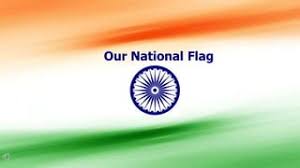
forgotten
The forgotten Man behind our Nation’s pride- The tricolor
As soon as Someone is identified as an Unsung hero, he no longer is- George carlin
What does one remember or possibly think of, upon hearing the name of any country, isn’t it the national flag?? The national flag is an embodiment of the principles and virtues upon which the nation was built. It further symbolizes and signifies the emancipation of the nation and the struggle behind it.
If there is one thing that is the synecdoche it is our National flag. We hoist it mostly on two important occasions every year and on certain occasions. It is a symbol of the struggle of our ancestors and the wisdom and zeal they intended to pass on to the next generations. We see the tricolor in every government office, on events and occasions of national and international importance, in the arena of sports, art and diplomatic relations.
The man behind the tricolor:
The man who designed the National flag of India, Pingali Venkayya is also a Freedom fighter, a linguist, a geologist, a scientist, and a teacher. A person with multiple talents and ideals akin to our national flag. The man whose face has to be etched in the minds of the billions whenever they come across the tricolor but which has not been the case.
Early childhood and education:
He was born on August 2, 1878 in Bhatlapenamuluru, Machilipatnam, Andhra Pradesh in a humble Agricultural family. He finished his high school in Machilipatnam and went to Madras and then Cambridge University for further studies. The values of nationality and patriotism were imbibed in him right from his childhood.
Boer War:
He went to Bombay, underwent training and joined the British Indian army. He participated in the Boer War in South Africa. It was at this time that he met Mahatma Gandhi in South Africa. Mr.Venkayya and Gandhi remained friends for quite a time. During his time in South Africa, Mr.Venkayya developed his perceptions and ideals of the world. After having witnessed the oppressive nature of the British since his childhood, his aversion and abhorrence towards them kept growing. His yearn to free the nation also prospered with time.
History behind the design of the tricolor:
While coming back from South Africa, he visited Afghanistan and Arabia, where he studied their political, social and financial status to understand the pertinence of gaining independence for India. After his arrival in india, he actively participated in the freedom movement. Though he respected Gandhi’s struggle for freedom and adored his patience, patriotism, and persistence, he was a staunch follower of Bala Gangadhar Tilak. He believed that one should fight and command for freedom instead of requesting and praying for it.
HIS BOOKS:
After Coming back to India, he published a book of flags containing 30 different designs in 1916. He wrote letters to freedom fighters including Mahatma Gandhi informing them about his idea of having a National flag and he spoke about it at Congress meetings.
Adoption of the National flag:
Venkayya went on designing many models of the national flag. In 1921, Mr.Venkayya presented the design of the flag to Gandhi at the Indian National congress meeting in Vijayawada. The model presented by Venkayya to the Mahatma had two stripes (green and red) and the Gandhian charkha at the centre. Gandhi suggested to add a white stripe on the top. Later it was replaced by the Ashoka Chakra. Though it was unofficially used on a plethora of occasions, it was officially adopted on 22 July,1947 by the constituent Assembly.
His desire for knowledge had no bounds. He had passion for learning different languages be it Indian or foreign. He was proficient at speaking Japanese, Sanskrit, Urdu and Hindi fluently.
Public meetings:
He was always given opportunities by congress leaders to address public meetings as he was a great orator. His voice not only reached thousands of people but also inspired and moved them.
RESEARCH ON SOILS AND COTTON:
In 1906, the unsung hero got a job offering from Ranga Rao Bahadur. The job was to look after agriculture or administration. He accepted the offer since he hailed from a farming family. He thought of spending the income for his further studies. He developed a sense of interest for research on soils and crops mostly revolving around how agriculture would contribute to the then India’s economy.
The cotton harvested in India was thick in nature, that the youth did not prefer. They fancied light-weight foreign clothes. With an object to see the Indian youth wearing Indian made-cotton clothes, the pioneer researched and imported seeds from Cambodia and and America. He utilized the seeds to produce a new variety of cotton, which was later called as “Cambodia cotton”. This research brought him great appreciation and a job at the national college in Machilipatnam. He worked there from 1911-1919.
Teaching:
He taught on subjects like soil fertility, history, physical education, NCC and military training. He strived to develop the feeling of patriotism in the minds of the young students and make them understand the importance of freedom struggle and the need for independence.
Personal life:
Being the eldest son in his family he had to get married prior to his younger brothers and sisters in order to provide them with the scope for marriage. So at the age of 32, he married 10 year old Rukmanamma, unwillingly. Mr. Venkayya was drawn back from active politics after Tilak passed away in 1920. He then switched his focus to studies and pursued courses in geology and mining.
Children:
Mr. Venkayya’s younger son, Chalapathi rao, worked in the Indian army. He succumbed to Tuberculosis at a very tender age. His parents were in depths of despair and devastation. The government had given small portion of land for Chalapathi rao’s service in the Indian army.
His last days:
At the final stages of his life, he was left with nothing but a small portion of land which was given by the government for his son’s service in the Indian army. It is evident that he never used his excellency in numerous subjects for money but for society and people. He is indeed a selfless hero, who never thought of approaching for help from his social contacts.
Unfortunately, Mr.Venkayya was so poor that his family could not even afford food. Briefly for a bit, his expertise in mining brought him some money. He became an Advisor in the Mines department and got an honorarium. Sadly, by 1960, the post was revoked, and the honorarium was withdrawn.
TWO WISHES:
Mr. Venkayya had two wishes, out of which only one was fulfilled.
He wanted to see the National flag hoisted at Redfort, but never did. Many Independence days and Republic days were celebrated between 1947 and 1963, but no one cared to ever invite Mr.Venkayya gaaru to witness the events in Delhi. The Prime Ministers, Presidents of several other countries were invited, but not Mr.Venkayya, who was the man behind the National flag, which we cherish and see it with immense pride.
Anonymous Death:
Before taking leave forever, he yearned to be wrapped in his National flag for his ceremony. Though it had taken place, only a handful of people participated in the last rites of Mr.Venkayya.
The National flag is used as a symbol to signify patriotism when it is wrapped around the bodies of our martyrs. It is flown even on the demise of National and International leaders. It is ironic that the man who designed such a significant part of our country’s heritage and culture died anonymously. The man who should have been lauded and admired by billions left this earth with a handful of people around him who barely knew his contribution to this country.
By: Bapathu Poojitha
Write and Win: Participate in Creative writing Contest & International Essay Contest and win fabulous prizes.


